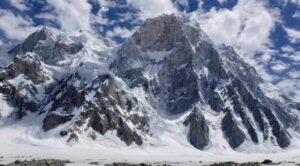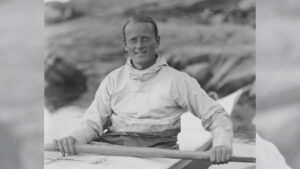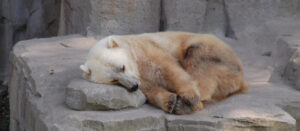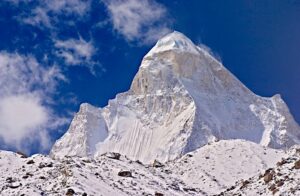In 1994, Noel Craine, Paul Pritchard, Steve Quinlan, and Jordi Tosas took on Mount Asgard’s north tower. This extreme climb on Canada’s Baffin Island had bested legendary mountaineer Doug Scott. How would this young but experienced group get on?
The mountains of Baffin Island
The jagged, fiord-riven east coast of Canada’s Baffin Island features some of the highest cliffs in the world. The highest peak is Mount Odin (2,147m), followed by Mount Asgard (2,015m), Mount Qiajivik (1,963m), Angilaaq (1,951m), Kisimngiuqtuq (1,905m), Ukpik (1,809m), Bastille Peak (1,733m), Mount Thule (1,711m), Angna (1,710m), and Mount Thor (1,675m). There is also a whole other area further north with slightly lower but equally world-class cliffs in Sam Ford Fiord, where the walls rise directly from the ocean.
In short, eastern Baffin offers amazing climbing.

Baffin Island. Photo: Wikipedia
Mount Asgard (2,015m)
Mount Asgard lies inland, in Auyuittuq National Park, on southeastern Baffin Island.
It has two huge cylindrical rock towers, the south tower and the slightly taller north tower, “like two sawn-off chimney stacks”, according to one description. The twin towers connect via a saddle.

Mount Asgard and its twin summits. Photo: Wikipedia
In 1934, British explorer Patrick Douglas Baird explored Greenland and northeastern Baffin Island. In 1938, he returned to Baffin Island, only to lose his companion Reynold Bray when a storm blew him out to sea, to a watery grave.
Scientists of the Swiss Foundation for Alpine Research, led by Patrick Douglas Baird, made the first ascent of the north peak of Mount Asgard in 1953. They climbed via the east side, then traversed across snowfields and rock ribs to the saddle between the two peaks. They then topped out on the north peak. See the end of this piece for more about this climb.
The first ascent of the south tower
The south tower was first climbed in 1971. Doug Scott, Guy Lee, Rob Wood, and Phil Koch ascended the 1,000m long south ridge. They then made an epic descent in a blizzard.

Doug Scott and his team at Summit Lake, Baffin Island, in 1971. Left to right: Steve Smith, Ray Gillies, Dennis Hennek, Guy Lee, Phil Koch, Doug Scott, and Rob Wood. Photo: Doug Scott
Scott and Dennis Hennek attempted to climb an elegant line on the northwest face of the north tower but were unsuccessful.
While waiting on the weather, the team read various books, including The Hobbit, War and Peace, and The Greening of America. Scott and companions split The Greening of America into pieces, so they could all read it at once. Reading the book like this brought them closer together. On the mountain, they also worked as a team, seeking the solution to problems.

Lawren S. Harris (1885-1970) painted Mount Odin and the mountains of eastern Baffin Island. Photo: Wikipedia
Scott later wrote: “We still dream of wandering back to this wilderness, carrying all we need on our backs, to climb those magnificent clean-cut dihedrals. Walk in unaided, unfettered, to learn the secrets of Asgard’s west face, or the 760m overhanging prow of Friga, or any others that should take our fancy.”
A year later, in 1972, Doug Scott did return to Baffin Island with Dennis Hennek, Paul Nunn, and Paul Braithwaite. They made the first ascent of the east pillar of Asgard. But the west face, one of the world’s greatest big-wall challenges, remained unclimbed.

Dennis Hennek leads the squeeze chimney on the east pillar of Mount Asgard in 1972. The pitch was later made significantly easier when seven bolts were placed up the side of the fissure. Photo: Doug Scott
Northwest face by Charlie Porter
American big-wall climber Charlie Porter was one of the most interesting climbing figures of his time. In the early 1970s, he established several new routes on El Capitan in Yosemite, including Zodiac (solo), Mescalito, Tangerine Trip, The Shield, and New Dawn (solo).

Charlie Porter, a climber way ahead of his time.
Between September 1 and 10, 1975, he completed one of his most important climbs. Porter soloed a huge route on the northwest face of the north tower of Asgard. Carrying all his equipment, it took a whole month for him to reach the foot of the mountain on skis. Then he climbed for nine days on the hard crystalline gneiss. The 5.10+ A4 route required 40 pitches.
The ordeal led to a serious foot injury. After descending the Swiss route, he had to cut off his boot to release the swollen foot. He had not eaten for 10 days. In this condition, he had to trek more than 48km to the nearest village. When he arrived, the local Inuit gave him a Coke.
Porter did not like to talk about his climbs, nor did he like to exaggerate. He graded this route as a VI, but it was clear to the rest of the world that Porter had completed Canada’s first VII climb — establishing a new level of commitment.
For months, not much was known about his Asgard route because Porter was against self-promotion. He didn’t even give the route a special name.
“The greatest achievement in Baffin, the Arctic, or probably anywhere,” Doug Scott wrote of Porter’s feat.

Dawn breaks across the mountains of Baffin Island, beyond the north face of Mount Asgard. Photo: Alastair Lee
1994
In the summer of 1994, five intrepid young climbers set off from the shores of Pangnirtung Fiord for the base of Mount Asgard. Their goal was to establish a new route, climbing 200m to the left of Charlie Porter’s line, on the west face of the north tower.

Skiing to the west face of Mount Asgard in 1994. Photo: Paul Pritchard
British climbers Noel Craine, Simon Yates, Keith Jones, and Paul Pritchard, along with American Steve Quinlan, brought more than 550kg of gear with them. They decided not to take a helicopter but instead, to hire a snowmobile and driver to pull their load to the start of Weasel Valley. After a long hike, they skied up the Caribou Glacier for five kilometres, then across the Turner Glacier for another four kilometres.

Free climbing in gnarly weather on the west face of the north tower of Mount Asgard, 1994. Photo: Paul Pritchard
It took them 13 days to reach Asgard, transporting everything on foot. Because of the weight, they sometimes had to shuttle their loads in pieces. Each carried at least 36kg of gear during each trip. In three days, they crossed the Arctic Circle five times. Fierce storms hit them on the Caribou Glacier.
“After 210km of hideous load-carrying, we decided that never had an expedition reached such depths before [even reaching] the mountain, ” Pritchard wrote in his book, Deep Play. “The food fantasies. The girlfriend fantasies. Warm beds, coal fires, and steamed pudding. We spent two days at the Caribou Col as deep snow drifted around our tents. It was a welcome rest from the constant grind.”

Tied-off pitons on Heading North, Mount Asgard north tower, 1994. Photo: Paul Pritchard
Scouting the line
Finally, they saw the west face of Asgard. They had brought a telescope to look at the face and scout their line. Huge patches of frost covered the wall, already in shade by late afternoon. The five climbers then hunkered down for more than 30 hours in a snow cave covered by a small tarpaulin, as violent winds buffeted their makeshift base camp.

Noel Craine on a homemade portaledge on the west face of the north tower. Photo: Paul Pritchard
Every time they went out on the glacier to try to reach the foot of the wall, they worried that avalanches could sweep them away at any moment. Food and time began to run short. Yates and Jones had a work commitment and would soon have to return to England.

The topography of the Hyperborea route, 1994. Photo: Paul Pritchard
A lone wolf
Apart from Craine’s small group, there was only one other climber in Auyuittuq National Park at the time. Jordi Tosas was on the other side of Asgard’s tower and had been attempting to solo a route on Friga from the Parade Glacier. His compatriots, Nestor and Nil Bohigas, had opened the route previously. Tosas had already tried to climb it, but bad weather forced him back to Base Camp.

From the diary of Jordi Tosas, Mount Asgard, 1994. Almost every arctic visitor at that time went north with a copy of Barry Lopez’s meditative book, Arctic Dreams. Photo: Jordi Tosas
In Base Camp, he left his backpack and gear and moved further down the valley during the storm. When he eventually returned to camp, he realized that his red backpack had disappeared in an avalanche. Tosas had lost everything.

Pangnirtung. Photo: Jerry Kobalenko
Back to Pangnirtung
Both Craine’s group and Tosas decided to walk the 80km back to the town of Pangnirtung. There, they said goodbye to Yates and Jones. Craine, Pritchard, and Quinlan offered Tosas the chance to join their group on Asgard’s west face. Tosas gladly accepted. They stayed a few days in Pangnirtung, camping beside the fiord and eating non-stop.
“It was as if we were together in Yosemite’s Camp 4, but with whales,” Tosas told Explorersweb.

Paul Pritchard and Noel Craine. Photo: Paul Pritchard
Second try at Asgard
On June 21, they took a boat toward the head of the fiord, then hiked across the pack ice and back in Auyuittuq National Park. They reached Asgard Base Camp on June 27.
Their chosen gully was now in better condition. With the weather improving, the climbers managed to set up an Advanced Base Camp. It was essentially another hole at the foot of the wall. At over 1,000m, they were going to spend a couple of days there.

Tosas on the west face of the tower.
Like Doug Scott and his colleagues before them, Craine and company also divided up a book. Arctic Dreams by Barry Lopez was pulled apart and passed around.
“How do people imagine the landscapes they find themselves in? How does the land shape the imaginations of the people who dwell in it? How does desire itself, the desire to comprehend, shape knowledge?” Lopez asked in his book. The book covered similar points to Reich’s The Greening of America, which Scott and companions had worked through 23 years earlier.
Craine was still a child when Scott attempted Asgard, but he had done his research and noted Scott’s warning: The west wall of Asgard’s north tower could not be climbed without drilling bolts.

Baffin Island, Asgard tower. Photo: Joshua Lavigne
A personal challenge
On June 29, Craine, Pritchard, Quinlan, and Tosas set out on the first pitch. However, the arrogance of youth had to take a bath of humility, as they tried to avoid the falling rocks on the huge monolith.
The group took turns on the red and yellow granite, opening pitches in pairs, while the other two rested. They pushed without stopping. The climbing was very exposed, and they injured the root of their nails as they clung to small, cold holds. Eventually, they reached the middle of the wall. Here, they fixed their portaledge.

A lonely little cloud floats above Mount Asgard. Photo: Will Christiansen
On one of the pitches, a shard of quartz shot out of a hole and buried itself in Craine’s eyeball. His eye swelled up and they couldn’t get the piece of rock out. He was in pain, and the team weighed what to do. They knew that there was a doctor with a German team 25km away in the Weasel Valley, but Craine would need a guide and that would mean the end of the journey for everyone else.
Eventually, Craine decided to push on. He eventually recovered, but the piece of Asgard remained lodged in his eye.
The climb
They tried to avoid drilling as much as possible. Mainly, they advanced using the tips of their nails and unstable hooks. The days passed quickly. Other climbers appeared at the foot of the mountain. They decided to climb non-stop, 24 hours a day, taking advantage of the midnight sun at this latitude. They were 200m above the portaledge and still 300m from the top of the tower.
The last stretch was brutal, with many difficult pitches. They thought it was an A4+ because they didn’t even dare to believe that they were climbing A5, where death consequences come with a fall. The 7a pitches resulted in brutally hard free climbing in subzero temperatures.

On the summit of the north tower of Mount Asgard, July 10, 1994. The first ascent of the west face. Photo: UKC Gear
After 30 hours of nonstop climbing, they topped out on July 10, 1994. They had drilled no more than twenty holes along the gigantic route.
Without speaking, they spent 20 minutes on top, separated from each other, merging with the Arctic nothingness. “A moment so empty that the entire universe could fit inside, without filling it,” Tosas recalls.
A final gift
From the top, Quinlan and Tosas spotted Tosas’s red backpack that had been swept away in the avalanche. They could not believe it! Another gift from the mountain. The avalanche had melted, and the backpack had appeared in its fan.
The descent lasted a day and a half. Pritchard named the route Hyperborea (1,000m VI A4+ 5.11). They climbed capsule-style, with multiple 60m ropes, and an extensive rack.
“To the north of the Arctic, beyond the tundra, beyond the vast sheets of ice, even beyond the pole, is a land more wonderful than a mortal’s most fanciful dream,” Pritchard eloquently wrote. “A magical land where trees bear fruit throughout the four seasons and wheat is harvested in loaves. The ancient Greeks called this place Hyperborea –- beyond the north wind –- and their boldest navigators went in search of a perfect life without toil or hunger. They never found their Hyperborea, but this is the story of how we found ours.”

Paul Pritchard, Noel Craine, Steve Quinlan, Jordi Tosas, and in the centre, Doug Scott.
Photos: Paul Pritchard, Mark Reeves, Jordi Tosas, Doug Scott
The 1953 climb

Hans Weber on Asgard, 1953. Photo: Richard Weber Collection
Shortly after this story came up, we heard from polar traveler Richard Weber. He’s best known for his unsupported 1995 expedition to the North Pole and back with Mikhail Malakhov, one of the great modern polar expeditions. Weber was also one of the first polar guides.
He pointed out that his father, Hans Weber, was part of that 1953 Swiss expedition to Asgard. “It was his first trip to Canada,” wrote Weber. “He never left.”

Hans Weber crosses the Weasel River on Baffin Island via a Tyrolean traverse. “My father was always good with ropes,” said Richard Weber. “I think they set the rope up in [early spring] because they knew they would have to cross in summer when they walked out.” Photo: Richard Weber Collection






